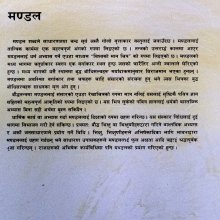Kalama, Kālāma, Kālamā: 20 definitions
Introduction:
Kalama means something in Buddhism, Pali, Hinduism, Sanskrit, Marathi, Jainism, Prakrit, Hindi, biology, Tamil. If you want to know the exact meaning, history, etymology or English translation of this term then check out the descriptions on this page. Add your comment or reference to a book if you want to contribute to this summary article.
Alternative spellings of this word include Kalma.
Images (photo gallery)
In Hinduism
Ayurveda (science of life)
Dietetics and Culinary Art (such as household cooking)
Source: Shodhganga: Dietetics and culinary art in ancient and medieval IndiaKalama (कलम) refers a variety of rice grown in Bengal, according to the Raghuvaṃśa IV.36-37, and is commonly found in literature dealing with the topics of dietetics and culinary art, also known as Pākaśāstra or Pākakalā.—The discussions on rice can be seen only in post-Ṛgvedic literature. [...] Raghuvaṃśa states that kalama variety of rice, which was grown in Bengal was transplanted in the banks of Ganges to attain full growth.
Unclassified Ayurveda definitions
Source: Wisdom Library: Āyurveda and botanyKalama (कलम) is a Sanskrit word for a species of rice (śāli) which is said to have a superior quality, according to Caraka in his Carakasaṃhitā sūtrasthāna (chapter 27), a classical Ayurvedic work. The word mahā means “great” or “large”. The plant Kalama is part of the Śūkadhānyavarga group of medicinal plants, referring to the “group of awned grains”. Caraka defined such groups (vargas) based on the dietic value of the plant. According to Monier-Williams, Kalama is “sown in May and June and ripening in December or January”.

Āyurveda (आयुर्वेद, ayurveda) is a branch of Indian science dealing with medicine, herbalism, taxology, anatomy, surgery, alchemy and related topics. Traditional practice of Āyurveda in ancient India dates back to at least the first millenium BC. Literature is commonly written in Sanskrit using various poetic metres.
Pancaratra (worship of Nārāyaṇa)
Source: archive.org: Isvara Samhita Vol 5Kalama (कलम) or Kalamaśāli refers to one of the ten varieties of “rice” (śāli) according to verse 25.60b-61 of the Īśvarasaṃhitā which deals with the classification of the places for building the fire-pits (kuṇḍa). Śāli represents one of the seven village-corns that are fit for food-offerings. Accordingly, “Śāli (e.g., kalama) is important among them. Others are to be taken in its absence or that of others”.

Pancaratra (पाञ्चरात्र, pāñcarātra) represents a tradition of Hinduism where Narayana is revered and worshipped. Closeley related to Vaishnavism, the Pancaratra literature includes various Agamas and tantras incorporating many Vaishnava philosophies.
In Buddhism
Theravada (major branch of Buddhism)
Source: Pali Kanon: Pali Proper Names1. Kalama - See Alara Kalama.
2. Kalama - The name, probably, of a gotta or family. Mention is made of a nigama belonging to them in Kosala, which was called Kesaputta. The sermon preached by the Buddha on his visit to Kesaputta is justly famous (A.i.188ff). The Kalamas were Khattiyas (AA.i.418). Among members of this family specially mentioned by name are Bharandu Kalama, who was once a co disciple of the Bodhisatta, and Alara Kalama, the teacher of Gotama before his Enlightenment.
Theravāda is a major branch of Buddhism having the the Pali canon (tipitaka) as their canonical literature, which includes the vinaya-pitaka (monastic rules), the sutta-pitaka (Buddhist sermons) and the abhidhamma-pitaka (philosophy and psychology).
Biology (plants and animals)
Source: Google Books: CRC World Dictionary (Regional names)Kalama in India is the name of a plant defined with Oryza sativa in various botanical sources. This page contains potential references in Ayurveda, modern medicine, and other folk traditions or local practices It has the synonym Oryza sativa var. elongata Desv. (among others).
Example references for further research on medicinal uses or toxicity (see latin names for full list):
· Aspects of Plant Sciences (1989)
· Handbuch des Getreidebaus (1885)
· J. Agric. Trop. (1956)
· Flora de Filipinas ed. 1 (1837)
· Proceedings of the Indian Science Congress Association (1987)
· Flora Cochinchinensis (1790)
If you are looking for specific details regarding Kalama, for example chemical composition, diet and recipes, health benefits, pregnancy safety, side effects, extract dosage, have a look at these references.

This sections includes definitions from the five kingdoms of living things: Animals, Plants, Fungi, Protists and Monera. It will include both the official binomial nomenclature (scientific names usually in Latin) as well as regional spellings and variants.
Languages of India and abroad
Marathi-English dictionary
Source: DDSA: The Molesworth Marathi and English Dictionarykalama (कलम).—n ( A kalama S) A paragraph: also a distinct head, item, article. 2 A graft or cion. 3 Ingrafting. 4 A painter's brush or pencil. 5 A pen. 6 Chopping off (of hands or feet). Sometimes used of the lopping and pruning of trees. 7 m f Fainting or swooning. v yē.
--- OR ---
kalamā (कलमा) [or कलम्हा, kalamhā].—m ( A The grand all-comprehending dogma of the Muhammadans, There is no god but God &c. The loud and fervid utterance of this the Marathas are pleased to interpret as, and to accept the word as signifying) A brawl, squabble, wild uproar, or mere vociferation. v kara, lāva, māṇḍa, mājava, uṭhava, cālava, & v i hō, lāga, māja, uṭha &c.
Source: DDSA: The Aryabhusan school dictionary, Marathi-Englishkalama (कलम).—n A pen. A paragraph, a distinct head. A painter's brush. A graft, chopping off, ingrafting. kalama karaṇēṃ To graft. To cut off, amputate.
Marathi is an Indo-European language having over 70 million native speakers people in (predominantly) Maharashtra India. Marathi, like many other Indo-Aryan languages, evolved from early forms of Prakrit, which itself is a subset of Sanskrit, one of the most ancient languages of the world.
Sanskrit dictionary
Source: DDSA: The practical Sanskrit-English dictionaryKalama (कलम).—[Uṇādi-sūtra 4.84]
1) Rice which is sown in MayJune and ripens in December-January; प्रसूतं कलमक्षेत्रं वर्षेणेव शतक्रतुः (prasūtaṃ kalamakṣetraṃ varṣeṇeva śatakratuḥ) Rām.4.14.16. सुतेन पाण्डोः कलमस्य गोपिकाम् (sutena pāṇḍoḥ kalamasya gopikām) Kirātārjunīya 4.9,34; Kumārasambhava 5.47; आपादपद्मप्रणता कलमा इव ते रघुम् । फलैः संवर्धयामासुरुत्खातप्रतिरोपिताः (āpādapadmapraṇatā kalamā iva te raghum | phalaiḥ saṃvardhayāmāsurutkhātapratiropitāḥ) || R.4.37. कलयता कलमावन- कामिनीकलमनोहरगानममन्यत (kalayatā kalamāvana- kāminīkalamanoharagānamamanyata) Rām. Ch.4.72.
2) A pen, a reed for writing with.
3) A thief.
4) A rogue, rascal.
Derivable forms: kalamaḥ (कलमः).
Source: Cologne Digital Sanskrit Dictionaries: Edgerton Buddhist Hybrid Sanskrit DictionaryKalamā (कलमा).—= prec.: Divyāvadāna 532.11 masinā (= maṣ°) kalamayā tūlena; 535.10 bhūrjāṃ (mss.) kalamā (so divide) tailaṃ tūlam asir (read masir or maṣir?).
--- OR ---
Kālāma (कालाम).—(= Pali id.), surname of Ārāḍa or Ar°, qq.v.; var. Kālāpa.
Source: Cologne Digital Sanskrit Dictionaries: Shabda-Sagara Sanskrit-English DictionaryKalama (कलम).—m.
(-maḥ) 1. Rice which is sown in May and June, and ripens in December or January; a white rice growing in deep water: see śāli. 2. A pen, a reed for writing with. 3. A thief, a rogue. E. kal to count, &c. and ama Unadi aff.
Source: Cologne Digital Sanskrit Dictionaries: Benfey Sanskrit-English DictionaryKalama (कलम).—m. A kind of rice [Rāmāyaṇa] 5, 74, 11.
— Cf. ; [Latin] calamus; [Old High German.] halm; A. S. haelme.
Source: Cologne Digital Sanskrit Dictionaries: Cappeller Sanskrit-English DictionaryKalama (कलम).—[masculine] a kind of rice.
Source: Cologne Digital Sanskrit Dictionaries: Monier-Williams Sanskrit-English Dictionary1) Kalama (कलम):—m. (√1. kal, [Uṇādi-sūtra iv, 84]), a sort of rice (sown in May and June and ripening in December or January), [Suśruta; Raghuvaṃśa] etc.
2) a reed for writing with;
3) cf. [Latin] calamus; [Greek] κάλαμος; and [Arabic] قلم
4) a thief, [cf. Lexicographers, esp. such as amarasiṃha, halāyudha, hemacandra, etc.]
5) Kālāma (कालाम):—See kālāpa.
Source: Cologne Digital Sanskrit Dictionaries: Yates Sanskrit-English DictionaryKalama (कलम):—(ma) 1. m. Rice sown in May and June; a pen; a slip; a thief.
Source: DDSA: Paia-sadda-mahannavo; a comprehensive Prakrit Hindi dictionary (S)Kalama (कलम) in the Sanskrit language is related to the Prakrit word: Kalama.
[Sanskrit to German]
Sanskrit, also spelled संस्कृतम् (saṃskṛtam), is an ancient language of India commonly seen as the grandmother of the Indo-European language family (even English!). Closely allied with Prakrit and Pali, Sanskrit is more exhaustive in both grammar and terms and has the most extensive collection of literature in the world, greatly surpassing its sister-languages Greek and Latin.
Hindi dictionary
Source: DDSA: A practical Hindi-English dictionary1) Kalama (कलम) [Also spelled kalam]:—[[kalama]] (nf) a pen; a painter’s brush; a school or style of painting; graft; cutting, chopping; the growth of hair on man’s temples; ~[kasāī] a hack-writer; one who practises butchery through one’s pen, one who misdirects or propagates ignorance through one’s writings; ~[kārī] engraving, painting with a brush; ~[dāna] a pen and ink case; pentray, penstand; ~[baṃda] penned, put into black and white, reduced to writing, written; •[karanā] to write down, to record in writing; hence [kalamabaṃdī] (nf); —[karanā] to chop off, to cut; to prune; —[kā dhanī] a master of the art of writing; —[ghasīṭanā] to scrible; —[ghisanā] to write insignificant things/ineffectively; —[calānā] to write; [cūmanā] lit. to kiss one’s pen —to immensely like an expression, to be all praise for (one’s writing); —[toḍanā] to work wonders in (one’s) writing; to write amazingly well; —[pheranā] to strike out or delete what is written; —[meṃ jādū honā] to work wonders with the pen;—[meṃ jora honā] to wield the pen effectively.
2) Kalamā (कलमा) [Also spelled kalma]:—(nm) the basic statement or confession of Mohammedan faith; —[paḍhanā] to repeat the Muslim confession of faith; to embrace Islam; —[paḍhānā] to initiate (somebody) into Islam.
...
Prakrit-English dictionary
Source: DDSA: Paia-sadda-mahannavo; a comprehensive Prakrit Hindi dictionaryKalama (कलम) in the Prakrit language is related to the Sanskrit word: Kalama.
Prakrit is an ancient language closely associated with both Pali and Sanskrit. Jain literature is often composed in this language or sub-dialects, such as the Agamas and their commentaries which are written in Ardhamagadhi and Maharashtri Prakrit. The earliest extant texts can be dated to as early as the 4th century BCE although core portions might be older.
Kannada-English dictionary
Source: Alar: Kannada-English corpusKalama (ಕಲಮ):—
1) [noun] rice in the husk, the seed of the aquatic cereal grass Oryza sativa of Poaceae family; paddy.
2) [noun] the paddy-field.
--- OR ---
Kaḷama (ಕಳಮ):—
1) [noun] rice in the husk, the seed of the aquatic cereal grass Oryza sativa of Poaceae family; paddy.
2) [noun] a field where rice is cultivated; a paddy-field.
--- OR ---
Kaḻama (ಕೞಮ):—[noun] = ಕೞವೆ [kalave].
Kannada is a Dravidian language (as opposed to the Indo-European language family) mainly spoken in the southwestern region of India.
See also (Relevant definitions)
Starts with (+63): Kalam-allakalam, Kalama-majavanem, Kalama-saga, Kalamabaja, Kalamabandi, Kalamacurna, Kalamadana, Kalamadani, Kalamadhava, Kalamadhavakarika, Kalamadhaviya, Kalamagi, Kalamagopavadha, Kalamagopavadhu, Kalamagopi, Kalamaha, Kalamahanaka, Kalamahatmya, Kalamahi, Kalamahima.
Ends with: Alara Kalama, Arada Kalama, Bakalama, Bharandukalama, Bikalama, Jaladakalama, Kherijakalama, Lakalama, Nirvamshi Kalama, Nirvamshi-kalama, Rakamakalama, Sisa-kalama, Taja Kalama, Tajakalama, Takiyakalama.
Full-text (+48): Karama, Kalamaka, Kalamagopi, Alara Kalama, Arada, Kesaputta, Akimcanyayatana, Kalamakedara, Kalapa, Kalamasthana, Kalama-majavanem, Kalamagopavadhu, Kalambuka, Kalamaudana, Kalamasutra, Kalabha, Kalamakasai, Sisa-kalama, Kalame, Taja Kalama.
Relevant text
Search found 54 books and stories containing Kalama, Kālāma, Kalamā, Kaḷama, Kaḻama, Kālamā, Kālam-ā, Kalam-a; (plurals include: Kalamas, Kālāmas, Kalamās, Kaḷamas, Kaḻamas, Kālamās, ās, as). You can also click to the full overview containing English textual excerpts. Below are direct links for the most relevant articles:
Guide to Tipitaka (by U Ko Lay)
Part 3 - Tika Nipata Pali < [Chapter VII - Anguttara Nikaya]
Buddha Desana (by Sayadaw U Pannadipa)
Chapter 1 - His Teaching < [Part III - The Dhamma]
Philosophy of language in the Five Nikayas (by K.T.S. Sarao)
8. The Faith and the Truth < [Chapter 3 - Language and Meaning as Reflected in the Five Nikāyas]
The Great Chronicle of Buddhas (by Ven. Mingun Sayadaw)
Part 33 - The Story of Pukkusa, the Malla Prince < [Chapter 40 - The Buddha Declared the Seven Factors of Non-Decline for Rulers]
Part 3 - The Buddha proceeding to Migadaya < [Chapter 9 - The Buddha Reflecting Deeply on the Profundity of the Dhamma]
Chapter 5 - Learning from and Discussing with Āḷāra and Udaka < [Volume 2.1]
Charaka Samhita (English translation) (by Shree Gulabkunverba Ayurvedic Society)
Chapter 27a - The group of awned cereals (Shukadhanya—monocotyledons) < [Sutrasthana (Sutra Sthana) — General Principles]
Chapter 14 - The therapeutics of Abdominal Piles (arshas-cikitsa) < [Cikitsasthana (Cikitsa Sthana) — Section on Therapeutics]


